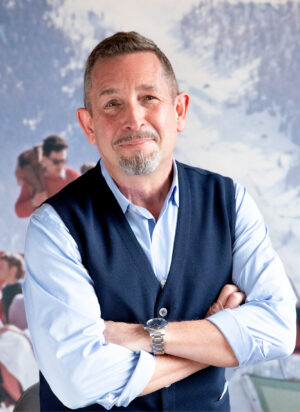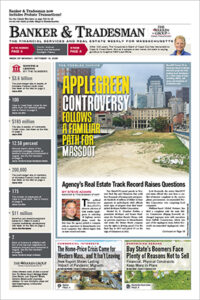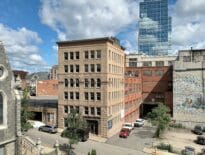David J. Hacin
Founding Principal and Creative Director, Hacin + Assoc.
Age: 60
Industry experience: 35 years
His architecture firm has grown to more than 30 employees and expanded its commercial work, but David Hacin likes to keep a hand in the design of Boston’s distinctive residences.
Hacin + Assoc.’s latest notable project is the 120-year-old Ayer Mansion in Back Bay, originally designed by Louis Comfort Tiffany, the lamp designer and son of the Tiffany & Co. founder. The 15,600-square-foot property and National Historic Landmark at 395 Commonwealth Ave. was most recently occupied by the Bayridge Residence & Cultural Center, a women’s student residence. Developers CNW Capital Partners and Sea-Dar Real Estate hired Hacin + Assoc. to design a conversion into a single-family home, which is currently listed for $17 million.
Born in Switzerland to an architect father, Hacin attended Princeton University and Harvard Graduate School of Design and landed his first architecture job in Boston at CBT Architects before founding Hacin + Assoc. in 1993.
Q: How has the firm’s focus shifted over the past three decades?
A: My father was an architect that did many of the same types of work, including private residences and multifamily properties around the city of Geneva. But I also do more retail, restaurant and office workplace projects. My father ended up being a real estate developer. I tried my hand in some development projects early on and realized that I don’t have the stomach for it. We started to design more freestanding projects and new builds throughout the neighborhood, including the Laconia Lofts, a 99-unit loft building that was the first new construction artist housing project in the eastern U.S. It was a catalytic project for redevelopment of this end of Washington Street.
Q: What percentage of Hacin + Assoc.’s current work is residential?
A: About 40 percent of our projects are focused on private residential work. It’s fairly unusual for a firm of our size. I enjoy it. It’s a much more personal line of design work and I’ve gotten to know really fantastic and interesting people. We get to explore details on a higher level than we would be able to do in a commercial context, and it’s very personal. Some of their kids have gone on to architectural schools. We get emails about how much their homes mean to them. When you’re working with developers, you’re going to design for a broad audience. When you’re doing a private residential project, most of them are for people who intend to live in their homes for a long time, it’s got to be much more customized and that is a big difference.
Q: Do your clients ask you to incorporate “smart home” technology?
A: I am someone who asks lots of tough questions for our clients. Sometimes there are things you actually think you want, but not use the way you might hope. Sometimes the husband is very focused on technology and the wife isn’t, or vice-versa. We all hear the jokes about who knows how to work the remote. If people have guests coming, are they going to be able to turn on the lights in the room if the system is too complicated? We did a home for a well-known executive of a very well-known tech company, and the house was actually very rustic but the technology was state-of-the-art. But our clients are very concerned about their carbon footprint and we are getting more requests for high standards of sustainability. I’m getting very few clients who are interested in gas cooking.
Q: The Ayer Mansion in Back Bay has been getting some national publicity as a notable project. How does the design reflect the unique characteristics of the property?
A: That was a very large home with many rooms and spaces. Designers love constraints, because it helps narrow the focus. There are these historic rooms and space and artifacts we have to work around as we were thinking about the possibilities. How would it look for a young family, or an extended family? We settled on a plan that would be a good set-up for a young family that would benefit from the kind of space that you often have in the suburbs, not the city.
Q: Did the developer consider a multi-unit redevelopment?
A: The issue is there is a historic staircase that is protected [as a landmark] that runs from the bottom of the house all the way through, so it makes that very difficult to do. We were really thinking hard about how to make it work as a single-family. We met with the Back Bay Architectural Commission, the Massachusetts Historical Commission and the Neighborhood Association of the Back Bay. They’ve all been very supportive. There’s a level of care and concern for the quality of work that’s built in the neighborhood that’s often absent in neighborhoods that have less protection. The results are fairly obvious. I know people like to express exasperation oftentimes with the process, but these neighborhoods in my opinion are what keep Boston special and humane, relative to many other cities that have spent less time caring about their resources.
Q: Wearing your hat as a member of the Boston Civic Design Commission, how do you view the critiques that recent developments are bland and lacking imagination?
A: Having had the privilege of reviewing many of the projects, I don’t think that any are bland at all. That is a hangover from years ago that’s just something people like to parade out. We have as many significant and important new pieces of architecture being built in this city as almost any other American city, and I’d be happy to talk to anybody about that. But there is also concern, however, with this building boom. There has been a lot of work built, particularly in the neighborhoods, that doesn’t necessarily meet the level of quality I would hope for the city. Unfortunately, land and building costs are extremely high and the pressure is how to build a good building in that context.
Hacin’s Five Great Things to Do in the South End
- Watching the opening day festivities of South End Youth Baseball in Peter’s Park.
- Taking the elevator down from his office to browse the new showrooms in Boston’s expanding SoWa Design District.
- Shopping for gently used titles in an actual bookstore at More Than Words on East Berkeley Street.
- Grabbing an exceptional cappuccino at the Kohi Coffee Co. walk up window of the Revolution Hotel.
- Instagramming his miniature schnauzer at the colorful dog park at Underground at Ink Block.







